
CAN THO JOURNAL OF SCIENCE AND TECHNOLOGY - No.05 - February, 2025
59
EFFECT OF FERMENTATION CONDITIONS ON ALCOHOL
CONTENT AND SENSORY VALUES OF FERMENTED
WATERMELON RIND BEVERAGE
Vi Nha Tran
1
, Nguyen Nhat Thanh
2
, Nguyen Ngoc Trang
2
and Truong Cong Vu
2
1Can Tho University of Technology
2Student of the Faculty of Biological, Chemical and Food Technology, Can Tho University of Technology
Email: vntran@ctuet.edu.vn
ARTICLE INFO
Received: 30/12/2024
Revised: 21/01/2025
Accepted: 10/02/2025
Keywords: Alcohol content,
fermentation, sensory
evaluation, watermelon rind
juice
ABSTRACT
This study investigates the potential of using watermelon rind, a
commonly discarded byproduct, to produce fermented beverages.
Watermelon rind, which constitutes 30% of the fruit's weight, is rich in
fiber and amino acids, offering significant nutritional benefits. The aim
was to optimize the fermentation process by adjusting factors such as
total soluble solids, pH, yeast concentration, and fermentation time to
enhance both alcohol production and the sensory qualities of the
beverage. Watermelon rind extract was adjusted to Brix values of 18,
20, and 22 °Bx and pH values of 3.8, 4.0, and 4.2, with Saccharomyces
cerevisiae RV100 yeast added at concentrations of 0.1, 0.2, and 0.3
g/L, and fermentation was conducted at room temperature for 1, 2,
and 3 days without agitation. The study found that the optimal
fermentation conditions were 20°Brix with a pH of 4.0. Specifically,
using 0.2 g/L of yeast and fermenting for two days resulted in a
beverage with 5.00% alcohol by volume and high sensory scores for
appearance, color, aroma, and taste. These results demonstrate that
watermelon rind can be repurposed into a valuable product, reducing
waste and supporting the growing fermented beverage market. Future
research will focus on product stability, shelf life, and nutritional
benefits.
1. INTRODUCTION
Vietnam, a nation with a tropical
monsoon climate, is one of the world's
biodiversity hotspots (Hoi & A.N, 2014),
offering a variety of fresh fruits, including
watermelon (Citrullus lanatus). Watermelon
is locally known by several names, such as
“tây qua,” “dưa đỏ,” and “hàn qua” (Yen,
2013). Typically, the flesh is consumed as a
dessert or processed into products such as
candy and juice, while the rind, which makes
up 30% of the fruit's total weight, is often
discarded, leading to significant waste (Bang,
2015; Dubey et al., 2022). Research has
shown that watermelon rind contains more
amino acids (165 mg/100 g) than the flesh
(146 mg/100 g) (Du et al., 2022), and is also
rich in fiber, which supports digestion and
can help prevent certain diseases (Lam,
2018; Zeng et al., 2014).
Given the rapid expansion of the
fermented beverage market, watermelon rind,
with its high nutritional value, presents a
promising opportunity. This study investigates
the effects of various fermentation conditions
on alcohol content and sensory qualities of
fermented watermelon rind beverages, aiming
to reduce waste by utilizing this byproduct.

CAN THO JOURNAL OF SCIENCE AND TECHNOLOGY - No.05 February, 2025
60
2. EXPERIMENTAL
2.1. Material and preparation
For consistency, watermelon rinds from the
Thanh Long variety were used, sourced from a
garden in Trung Binh Commune, Tran De
District, Soc Trang Province. Fresh, green rinds,
free from physical damage, were selected. The
green outer and white inner layers of the rind
were separated and washed thoroughly to
remove impurities. The prepared rind, shown in
Figure 1, was then analyzed for various
physicochemical properties.
Saccharomyces cerevisiae RV100 (Angel
Yeast Co., Ltd.), a commercial yeast strain, is
pre-activated prior to use at a 1:10 ratio (yeast
to rind extract, w/v).
Figure 1. Watermelon rind material
Analyzed Parameters: Moisture content
(%), total acid content (%), total soluble solids
(°Brix), pH value, reducing sugar and total
sugar content (mg%), ash content (%).
2.2. Experimental design
After extracting juice from the watermelon
rind, a single-layer cloth was used to filter it.
the Brix level of the juice was adjusted to 18,
20, and 22°Brix by adding sugar, and the pH
was adjusted to 3.8, 4.0, and 4.2 using citric
acid. The juice mixture was then sterilized by
adding 120 mg/L of NaHSO₃ and left for 2
hours. Subsequently, the sterilized juice was
inoculated with Saccharomyces cerevisiae
yeast at concentrations of 0.1, 0.2, and 0.3 g/L.
The fermentation process was conducted at
room temperature for 1, 2, and 3 days without
shaking. Following fermentation, the juice was
filtered through 16 layers of cloth, and 0.7 g/L
of pectin was added to the filtrate. The
fermented juice was then bottled in sterilized
glass containers (at 121°C for 5 minutes) and
pasteurized at 70°C for 10 minutes to inhibit
and eliminate any remaining microorganisms.
The final product was then evaluated based on
several parameters.
Evaluated parameters: Alcohol content (%
v/v) and sensory qualities, including
appearance, color, aroma, and taste.
2.3. Analytical methods
The analytical and evaluation methods
employed in this study included moisture
content (%) was determined by oven-drying
to a constant weight at 100–130°C (Hanh et
al., 2022).
Total acid content (%) was measured by
titration with a standardized base using
phenolphthalein (Anh et al., 2020).
Total soluble solids (
o
Brix) was assessed
with a handheld refractometer, while pH was
measured using a pH meter.
Reducing sugar and total sugar content
(%) were quantified using the dinitrosalicylic
acid method (Miller, 1959).
Alcohol and ash contents were determined
according to Vietnam standards
(TCVN8008:2009; TCVN10691:2015).
Sensory evaluation was performed using a
preference rating scale from 0 to 5 points,
where differences in appearance, color,
aroma, and taste were compared based on
TCVN3215-79 (TCVN3215-79). A panel of
10 university students with expertise in food

CAN THO JOURNAL OF SCIENCE AND TECHNOLOGY - No.05 - February, 2025
61
and sensory evaluation techniques conducted
the assessment. The evaluation focused on the
following parameters: appearance, color,
aroma, and taste.
2.4. Data processing
Experimental data were presented as
means and standard deviations using
Microsoft Excel 2010, with each experiment
repeated three times. Statistically significant
differences between samples were evaluated
using ANOVA with Statgraphics Centurion
XV.I and mean values were compared using
the Least Significant Difference (LSD) test
with a significance level of 5%.
3. RESULTS AND DISCUSSION
3.1. Analysis of physicochemical
properties and chemical composition of
watermelon rind
In the production of fermented beverages,
understanding the composition of raw
materials is crucial to optimizing fermentation
parameters. The analysis of the chemical
composition and physicochemical properties
of watermelon rind is shown in Table 1.
Table 1. Physicochemical properties and
chemical composition of watermelon rind
Component Unit Content
Moisture content % 94.51 ± 0.63
Total soluble
solids °Brix 3.00 ± 0.00
pH value - 5.64 ± 0.02
Total acid
content % 0.55 ± 0.06
Total sugar
content % 1.05 ± 0.28
Reducing sugar
content % 0.68 ± 0.35
Ash content % 0.78 ± 0.00
Note: The values in the table were the
averages of three repetitions
The results in Table 1 indicate that
watermelon rind consists primarily of water,
accounting for 94.51% of its total weight.
This is consistent with findings from
Athmaselvi et al. (2012), who reported that
watermelon rind contains approximately 95%
water (Athmaselvi et al., 2012). The ash
content, which measures the inorganic
components present in the rind, was 0.78%,
indicating the proportion of mineral mineral
compound proportions found in the rind
(Odewunmi et al., 2015).
The soluble solids content of watermelon
rind was measured at 3.00°Brix, which is
relatively low for a substrate intended for
fermentation. This low Brix (3.00 °Brix)
value suggests that the natural sugar content
of the rind is not sufficient for producing a
significant amount of alcohol during
fermentation (Hanh et al., 2022). Therefore,
adjusting the soluble solids by adding sugar
was necessary to achieve a balanced flavor
and an acceptable level of alcohol production.
Watermelon rind was found to have a total
acid content of 0.55%, and both total sugar
(1.05%) and reducing sugar (0.68%) levels
were relatively low. Moreover, the initial pH
value of 5.64 is higher than the optimal pH
range for fermentation, which is typically
between 3.8 and 4.2 (Thanh et al., 2013). A
higher pH may hinder yeast activity and
fermentation efficiency. Thus, to achieve a
product with desirable sensory qualities and
adequate alcohol content, it was essential to
adjust the pH and soluble solids content
before fermentation.
3.2. Investigation of the effects of
soluble solids and pH on alcohol content
and sensory qualities of the product
Throughout the fermentation process, the
levels of soluble solids and the pH of the
medium played a crucial role in influencing
the outcome of fermentation. The closer the
added sugar content and pH value were to the
optimal pH, the more favorable the
fermentation process would be (Phong et al.,
2017). The effects of initial soluble solids

CAN THO JOURNAL OF SCIENCE AND TECHNOLOGY - No.05 February, 2025
62
content and pH on alcohol content were
shown in Table 2.
Alcohol content index
During fermentation, yeast converts part
of the substrate into biomass and the
remaining substrate into ethanol and by-
products such as glycerol and pyruvate
(Minebois et al., 2020). The alcohol content is
largely dependent on the sugar concentration
in the fermentation medium (Mohd Azhar et
al., 2017). Data from Table 2 shows that
increasing the soluble solids from 18°Brix to
20°Brix enhanced the alcohol content after
two days of fermentation. However, further
increasing the Brix level to 22°Brix resulted
in a reduction in alcohol content. The typical
fermentation range for commercial
Saccharomyces cerevisiae RV100 that
optimal performance is between 18 and
24°Brix, with peak performance at 20–
22°Brix. Beyond 22°Brix, increased osmotic
pressure likely inhibited yeast growth, leading
to lower alcohol yields (Hien et al., 2022).
Table 1. Alcohol content and sensory evaluation of the product at different soluble solids
and pH levels
Sensory evaluation
Brix pH
Alcohol
content
(% v/v) Appearance Color Aroma Taste
3.8 2.83
a
3.67
ab
3.53
ab
2.77
a
2.80
a
4.0 3.30
b
3.57
ab
3.43
ab
2.83
ab
3.10
b
18
4.2 3.57
c
3.53
ab
3.40
a
2.93
abc
3.43
cd
3.8 4.47
f
4.13
c
4.00
d
3.83
d
4.17
f
4.0 5.03
h
4.70
d
4.57
e
4.43
e
4.70
g
20
4.2 4.83
g
4.10
c
3.97
cd
3.77
d
4.33
f
3.8 4.43
f
3.83
bc
3.70
bc
3.00
abc
3.67
de
4.0 4.00
d
4.00
c
3.87
cd
3.20
c
3.37
bc
22
4.2 4.20
e
3.40
a
3.27
a
3.07
bc
3.83
e
F = 34.040
P = 0.0000
F = 3.4500
P = 0.0090
F = 3.9000
P = 0.0043
F = 3.7700
P = 0.0054
F = 8.0900
P = 0.0000
Note: Values with different letters in the same column are significantly different (p < 0.05)
Additionally, pH plays a crucial role in
fermentation. Raising the initial pH from 3.8
to 4.0 within the same °Brix level increased
alcohol production, but a further increase to
4.2 reduced alcohol yield. This is because
pH affects yeast cell wall permeability,
which impacts nutrient absorption and
fermentation efficiency (Quan et al., 2016).
The sample with 20°Brix and a pH of 4.0
produced the highest ethanol content (5.03%
v/v), meeting the desired alcohol content for
fermented juice products, which is around
6.0% v/v (Tu, 2019).
Sensory evaluation index
The sensory evaluation results, shown in
Table 2, reveal the influence of soluble solids
content and pH on the sensory attributes of the
fermented watermelon rind beverage. Overall,
significant differences were observed across
the treatments in terms of appearance, color,
aroma, and taste.
The treatment with 20°Brix and a pH of
4.0 received the highest sensory scores, with
ratings of 4.70 for appearance, 4.57 for color,
4.43 for aroma, and 4.70 for taste. At this

CAN THO JOURNAL OF SCIENCE AND TECHNOLOGY - No.05 - February, 2025
63
combination of soluble solids and pH, the
product exhibited a smooth, uniform liquid
without any suspended solids or sediment. It
retained the characteristic green color of the
watermelon rind, had a mild alcoholic aroma
typical of fermented beverages, and preserved
the distinct aroma of the raw material.
In terms of taste, the balance between
sourness and sweetness was particularly well-
received by the testers, making the beverage
both easy to drink and highly appealing. This
harmonious combination of flavor
components contributed to the high sensory
scores across all categories.
By comparison, the treatments with higher
or lower Brix and pH levels tended to produce
beverages with less favorable sensory
attributes. For example, the sample with
18°Brix and pH 3.8 had a lower taste score
(2.80), which was likely due to insufficient
sugar content, resulting in a less balanced
flavor. On the other hand, samples fermented
at 22°Brix with a higher pH level (4.2)
showed diminished aroma and taste qualities,
possibly due to cross-over fermentation or
excessive sugar levels, which affected the
overall flavor profile.
These results indicate that a balance of
20°Brix and pH 4.0 produces the most
favorable sensory qualities in a fermented
watermelon rind beverage. The combination
yielded a product that was visually appealing,
had a pleasant aroma, and offered a balanced,
enjoyable taste. Thus, the sample with an
initial Brix level of 20 and a pH of 4.0 was the
most suitable for the product's requirements.
3.3. Impact of yeast content addition on
alcohol content and sensory values of
products
The amount of yeast added during
fermentation had a significant effect on both
the alcohol content and the sensory qualities
of the final product, as shown in Figure 2.
Figure 2. Alcohol content results and
sensory evaluation of products at different
yeast concentrations
Alcohol content index
Yeast concentration significantly affected
the soluble solids, pH, and ethanol content of
the fermented products, which in turn
influenced the sensory qualities. Low yeast
density could lead to prolonged fermentation,
reduced ethanol production, and the risk of
spoilage. In contrast, high yeast density
primarily increased biomass production,
resulting in a beverage with a bitter taste and
strong aroma due to the overproduction of
ethanol and by-products (Mi & Tien, 2021).
While a low yeast concentration may
extend fermentation time and reduce
efficiency, leading to poor product quality,
excessive yeast supplementation can
accelerate initial fermentation but hinder
subsequent processes. Rapid fermentation at
high yeast density also increases production
costs due to the extended propagation required
(Tam et al., 2021).
Figure 2 illustrates that alcohol content
varied significantly with yeast concentrations
of 0.1 g/L, 0.2 g/L, and 0.3 g/L. As yeast
concentration increased, ethanol production




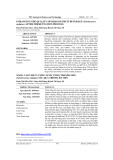
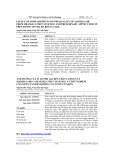

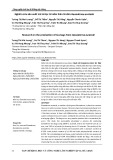
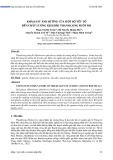
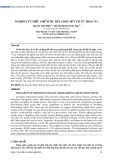
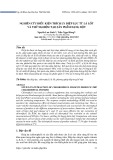







![Đề cương môn Công nghệ chế biến khí [năm học]](https://cdn.tailieu.vn/images/document/thumbnail/2025/20250910/thangkho12072002@gmail.com/135x160/88581757470791.jpg)

![Đề cương Công nghệ Polyme và Compozit [mới nhất]](https://cdn.tailieu.vn/images/document/thumbnail/2025/20250901/hungngao2711/135x160/24771756869342.jpg)
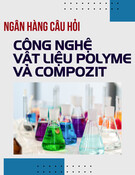



![Ứng dụng kỹ thuật trao đổi ion trong điện phân: Bài tiểu luận [chuẩn nhất]](https://cdn.tailieu.vn/images/document/thumbnail/2025/20250829/sonphamxuan1808/135x160/97341756442892.jpg)
